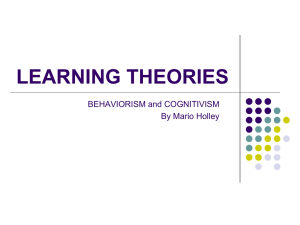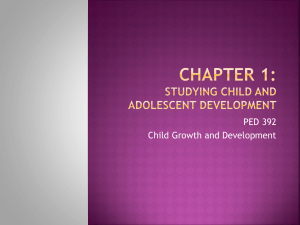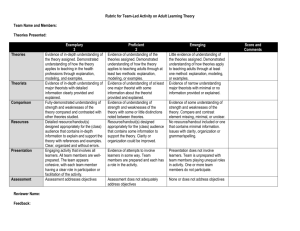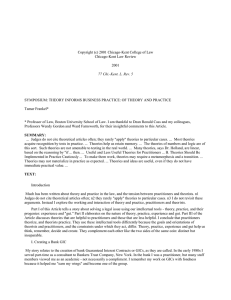Process of Play
advertisement
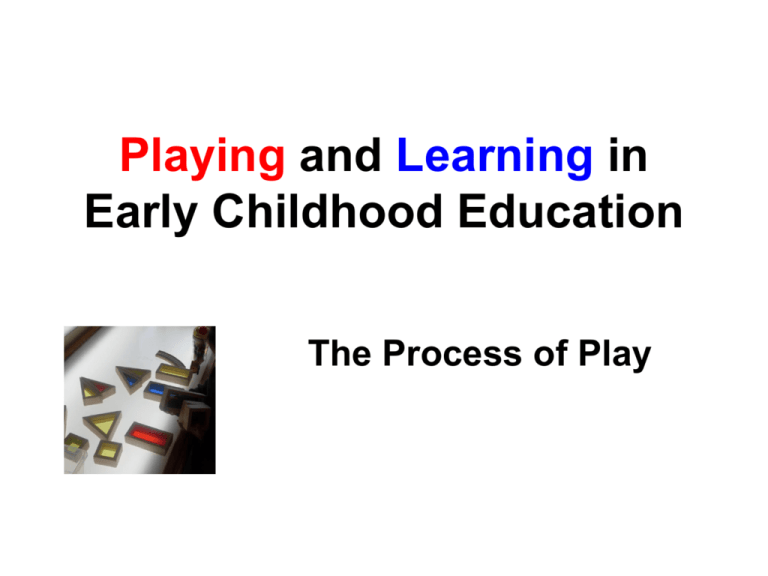
Playing and Learning in Early Childhood Education Chapter Two The Process of Play Opening Reflection In play the child is always behaving beyond his age, above his usual everyday behavior; in play he is, as it were, a head above himself. Lev Vygotsky, 1978 Overview An Ecological Perspective Motivation Engagement Process Early Learning Practitioner Atypical Development The Process of Play Characteristics The Play Process Theories Classifying Play Play from an Ecological Perspective Bronfenbrenner’s ecological theory examines how environmental influences contribute to a child’s play through the five environmental systems: Microsystem Mesosystem Exosystem Macrosystem Chronosystem Play from an Ecological Perspective Microsystem: Play is influenced by the child’s family Mesosystem: Play is influenced by the interactions and relationships between the family and early learning practitioners Exosystem: Play is influenced by federal, provincial, and territorial policies Macrosystem: Play is influenced by culture and societal ideologies Chronosystems: Play is influenced by environmental conditions and timing of events How Children Learn and Play From a constructivist perspective children’s play experiences require: Children and adult interaction and artifacts to support the process of understanding new information within a social context Children to share the physical space and social process as well as participate an internal process in order to make sense of the learning Both individual and groups of learners for an effective learning process Unique Features of Play Motivation Active engagement Process rather than product Play, Learning, and Motivation Intrinsic motivators of play is affected by: Challenge Curiosity Fantasy Play, Learning, and Motivation Play and intrinsic motivation are interrelated and influence child’s play in the following ways: Intrinsically motivated children act for the fun or challenge of play rather than for external products, pressures, or rewards Negative emotions, such as anxiety and stress, detract from a child’s interest in playing and exploring Structured environments that confine children to specific activities or events reduce play Play, Learning, and Motivation Early learning practitioners support children in developing self-regulation because it is interconnected to: attention skills memory cognitive flexibility interpretation of behaviour social interactions Play, Learning, and Motivation According to Pascal (2009), selfregulation: Is defined as “The ability to adapt one’s emotions, behaviours, and attention to the demands of the situation” (p. 1) about “Establishing one’s own internal motivation for adapting to, and understanding emotional and social demands (p.1) Is Play, Learning, and Motivation A child’s level of self-regulation and internal motivation is connected to his ability to: Exercise patience and persistence Exhibit flexibility, curiosity, and exploratory play Approach new experiences Reduce bullying tendencies Play, Learning and Active Engagement Active engagement in play is children’s work during their early years and leads children to develop skills and abilities in: language development cooperation sharing problem solving expansion of curiosity coordination of body skills Play, Learning and Active Engagement Children require active play to support them in: Developing skills to manage stress and to formulate a healthy lifestyle Acquiring a balance of vigorous play and quieter activities to enhance each of the child’s developmental domains Play, Learning, and Play as a Process rather than Product Children’s play experiences should: Focus on the process of play rather than the production of a product Allow children to be in control of their play by being given the freedom to engage in play, explore, and to be able to make mistakes without the feeling of failure Evolve from the child, be voluntary and self-initiated. Characteristics of Play According to Henniger (2002) and Isenberg and Jalongo (2010), there are seven common characteristics of play: Play is active Play is childinitiated and focused Play is processoriented Play is intrinsic Play is episodic Play is rulegoverned Play is symbolic The Play Process Children advance through five phases in the play process. They are: Phase Phase Phase 1: Body Play 2: Motoring Movement Play 3: Imaginative Play Phase 4: Intentional Imaginative Play Phase 5: Peer Play with Rules The sixth phase occurs during adulthood Phase 6: Adult Play Classifying Play Experiences Piaget (1970) suggests children participate in three distinct stages of play. They are: Functional/sensorimotor play (birth to age 2) – Children focus their play on simple, repetitive muscle-like movements with people, objects, and sounds Symbolic/dramatic play (ages 2 to 7) – Children focus their play on beginning to express fantasy, use props, and take on roles other than being children Games with rules (school-aged children) - Children negotiate the rules before they engage in a play experience Classifying Play Experiences Sarah Smilansky (1968) made significant additions to Piaget’s play stages. She identified that: Children between the ages of 4 and 6 years of age participate in social/dramatic play that is complex and sophisticated. She labeled this as a constructive play stage Classifying Play Experiences Mildred Parten (1933) examined play from a social-behaviour perspective. She identified that play progresses through a series of stages: Solitary Play - the child generally plays alone. There is limited or no interaction with other children or materials that other children use Parallel Play—Children begin to either play independently or beside peers—they do not play with peers Associative Play—Children begin to share play materials and participate in similar activities Cooperative Play—Children participate in group play. They determine a common goal and then each child works towards meeting the goal Classifying Play Experiences Parten identified non-playing roles as unoccupied behaviour time and onlooker play: Behaviour – Children are not engaged in play; they appear to be wandering in the play area without a defined purpose. Unoccupied Play – Children observe other children or adults in play but do not become involved in the play. Children may use this strategy to ask questions, learn about materials or determine how they may participate in a play episode. Onlooker Classifying Play Experiences Seagoe (1970) identified: As children approach 7–9 years of age, they participate in cooperative competitive play Children and Theories of Play Classical theorists examine play through theories of: Surplus-energy theory Recreation/relaxation theory Practice theory Recapitulation theory Children and Theories of Play Modern theorists examine play from the perspective of why play exists and the consequences of play for the child: Psychoanalytic theory (Freud and Erikson) - through play, children act out feelings and work through challenges through role switching and repetition Cognitive-developmental theory (Bruner, Piaget, SuttonSmith) - Play is a venue for children to use materials, interact with people, and build knowledge about the world they live in Neurobiological theory – Play strengthens the child’s neural network Children and Theories of Play Contemporary theorists examine play from current societal issues such as diversity, social justice, and the relative nature of truth and knowledge. Sociocultural theory – children learn about their social and cultural contexts through play Goncu – The values and beliefs that adults have about play, directly influences the quality of the play experiences that are extended to children Vygotsky – Zone of Proximal Development (ZPD) through play, children stretch their boundaries to figure out situations and then construct knowledge Children and Theories of Play Contemporary theorists examine play from current societal issues such as diversity, social justice, and the relative nature of truth and knowledge. Bronfenbrenner – a child’s development is impacted by both the person and their environment, which includes family, community, culture, and society Critical educational theory – critical theorists examine how play is influenced by gender, class, and race inequalities within society Play and Children with Atypical Development Children with atypical developmental patterns may: Participate in play differently from children with typical developmental patterns Early learning practitioners continuously observe each child to understand their play patterns, interests, and needs The Role of the Early Learning Practitioner Early learning practitioners promote children’s play by: Role modeling positive attitudes towards play Preparing appropriate play environments Observing children in their play Promoting play and opportunities for expansive discoveries The Role of the Early Learning Practitioner The Early learning practitioner engages in the appropriate level of participation in child’s play experiences play – the adult plays beside the child Co-playing – play episodes include a child or group of children and an adult. Play Tutoring – the adult, a child or group of children play as the adult leads the play for a short period of time. Parallel Summary Bronfenbrenner Ecological Theory The Role of Early Learning Practitioners Motivation Engagement Process Process of Play Atypical Development Classical Modern Contemporary Theories Characteristics The Play Process Piaget, Smilansky Parten Seagoe

